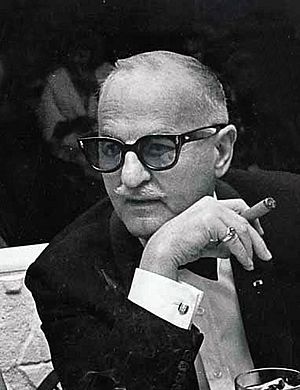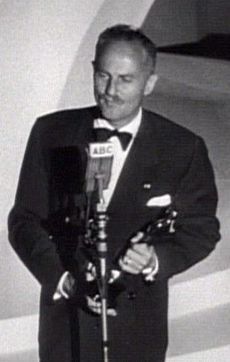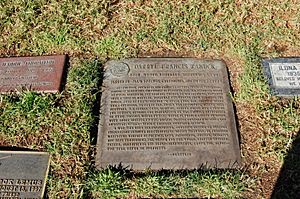Darryl F. Zanuck facts for kids
Quick facts for kids
Darryl F. Zanuck
|
|
|---|---|

Zanuck in 1964
|
|
| Born |
Darryl Francis Zanuck
September 5, 1902 Wahoo, Nebraska, U.S.
|
| Died | December 22, 1979 (aged 77) Palm Springs, California, U.S.
|
| Resting place | Westwood Village Memorial Park Cemetery |
| Years active | 1922–1970 |
| Spouse(s) | |
| Children | 3, including Richard D. Zanuck |
| Relatives | Dean Zanuck (grandson) |
Darryl Francis Zanuck (September 5, 1902 – December 22, 1979) was a famous American film producer and studio boss. He started by writing stories for movies during the silent movie era. Darryl Zanuck was a very important person in the Hollywood studio system, which was the way movies were made back then. He worked in Hollywood for a very long time, and he produced three films that won the Academy Award for Best Picture, which is a huge honor!
Contents
Early Life and First Steps in Film
Darryl Zanuck was born in Wahoo, Nebraska. His father owned a hotel. Darryl had an older brother, Donald, who sadly died young. When Darryl was six, he moved to Los Angeles with his mother because of her health.
At age eight, he got his first movie job as an extra (a background actor). But his father made him come back to Nebraska. In 1917, when he was only 15, he pretended to be older to join the United States Army. He served in France during World War I.
When he came back to the U.S., he worked many small jobs while trying to become a writer. He started writing movie ideas and sold his first story in 1922. He then worked for Mack Sennett and FBO. He wrote stories for the famous dog Rin Tin Tin and wrote over 40 scripts for Warner Bros. between 1924 and 1929. In 1929, he moved into management and became the head of movie production in 1931.
Becoming a Studio Leader
In 1933, Darryl Zanuck left Warner Bros. after a disagreement about his salary. A few days later, he teamed up with Joseph Schenck to start a new company called 20th Century Pictures, Inc.. They got financial help from other important people in Hollywood. Their new company released its movies through United Artists.
For a short time (1933–1935), 20th Century Pictures became the most successful independent movie studio. Almost all of their 19 films made a profit and broke box-office records! Some of their successful movies included Les Miserables. In 1935, Zanuck and Schenck merged their studio with the struggling Fox studios. This created the Twentieth Century-Fox Film Corporation.
Darryl Zanuck became the Vice President of Production for this new studio. He was very involved in making movies. He worked closely on scripts, film editing, and producing every film.
Serving in World War II
When the U.S. joined World War II in late 1941, Darryl Zanuck became a colonel in the Army Signal Corps. He wanted to be where the action was. He asked for a more dangerous assignment from General George C. Marshall.
Marshall sent Zanuck to London to work with the British Army film unit. He studied army training films while Nazi planes bombed the city during the Blitz. Zanuck was brave and even hosted "blitz parties" from his hotel room to watch the anti-aircraft fire. He even went on a secret military raid across the Channel to occupied France. He sent his wife a package of "Nazi-occupied sand" from the beach!
While Zanuck was serving, 20th Century-Fox, like other studios, helped with the war effort. They released many male stars for overseas service and female stars for USO tours. They also made patriotic films. Unlike some other studio heads, Zanuck actually went to war. He covered the invasion of North Africa for the Signal Corps.
Director John Ford was also making films for the U.S. Navy. He was surprised to be drafted into Zanuck's unit in Africa. After three months, Zanuck quickly put together a film from their footage of battles in Tunisia. The movie, called At The Front, was not well-received. This led to an investigation by Senator Harry S. Truman about famous Hollywood people becoming colonels.
In 1944, Darryl Zanuck resigned from the Army. He had accidentally shared a secret about a new bomb. Despite writing a book about his wartime adventures, he left the military.
Leading the Studio Again: 1944–1956
Darryl Zanuck returned to 20th Century-Fox in 1944. He took over again when the person he left in charge, William Goetz, left for another job.
In the 1940s and 1950s, Zanuck made smart choices for the studio. He helped make The Song of Bernadette (1943) a surprise hit. He also allowed Otto Preminger to direct Laura (1944), which was very successful.
Zanuck also supported director Elia Kazan. He chose Kazan to direct Gentleman's Agreement (1947), which was one of the first studio films to deal with antisemitism. This movie showed a reporter pretending to be Jewish to expose prejudice. He later brought Kazan back to direct Pinky (1949), another film about racial prejudice.
Other successful films under Zanuck included All About Eve (1950), which won six Academy Awards, and Twelve O'Clock High (1949). These films showed Zanuck's skill in making popular movies that also explored important social issues. However, some of his more idealistic projects, like Wilson (1944), did not do well at the box office.
The Rise of CinemaScope
In the early 1950s, television started to take away movie audiences. Hollywood looked for new ways to attract people. widescreen movies seemed like a good idea. Movies were usually shot in a near-square shape, like early TV screens.
Zanuck believed in widescreen movies. He invested a lot of money into a new system called CinemaScope. This system would use a special lens to squeeze a wide image onto regular film, and then another lens in the projector would widen it back out on a huge screen. This made the movie feel much bigger and more exciting than watching TV.
The studio was in financial trouble, and Zanuck and the president, Spyros Skouras, decided to bet on CinemaScope to save their jobs and the studio. Skouras announced that all Fox films would be released in CinemaScope, even though the system wasn't fully ready! The Robe (1953), a Biblical epic, was chosen as the first movie.
Fox engineers worked hard to perfect the system. Zanuck showed CinemaScope to the press and other studios. The new system allowed a wide, Cinerama-like picture using only one projector instead of three. This impressed everyone and helped Fox win a fight against a shareholder who wanted to take over the company.
Directors and cameramen had to learn how to use the new wide screen. Zanuck encouraged them to spread the action across the screen to use the new space. Fox even dropped some projects that wouldn't work well in CinemaScope, like Elia Kazan's On the Waterfront (1954). Other studios like MGM and Disney also started using CinemaScope.
However, the effort of creating CinemaScope seemed to tire Zanuck out. He started spending more time in Europe.
Becoming an Independent Producer
In 1956, Darryl Zanuck stepped back from running the studio. He moved to Europe to focus on making independent films. Fox gave him a special contract that allowed him to direct and choose actors for movies they financed.
While he was away, Fox started having big problems. Their movie Cleopatra (1963) went way over budget.
Meanwhile, Zanuck found a book called The Longest Day, which was about D-Day (the famous World War II invasion). He wanted to make the best movie ever about D-Day. He flew back to the U.S. and convinced the Fox board to finance the film. Even though Cleopatra was costing them a fortune, he believed The Longest Day would be a huge hit, and it was! He even had to use his own money to finish the film.
Returning to Fox
Zanuck returned to Fox to take control again. He replaced Spyros Skouras as president because of the huge costs of Cleopatra. He also made his son, Richard D. Zanuck, the head of production.
Richard Zanuck quickly showed he had a talent for picking new hits. He turned a less successful Broadway show into the very popular movie The Sound of Music (1965). He also supported the science-fiction film Planet of the Apes (1968) and the antiwar comedy MASH (1970).
However, Darryl Zanuck Sr.'s next World War II film, Tora! Tora! Tora! (1970), had many problems during production. Directors left, storms destroyed sets, and the Japanese co-director had to be hospitalized. When the film was finally finished, it was not popular because it showed an American defeat, which audiences didn't want to see during the Vietnam War.
Richard Zanuck also had some expensive movie failures, like the costume musicals Doctor Dolittle (1967) and Hello Dolly (1969).
Later Years and Legacy
By the end of the 1960s, Darryl Zanuck Sr. was spending a lot of money on projects for his new girlfriend in Europe. She even had her own contract to produce and star in his films. Her first movie, Hello-Goodbye (1970), lost the studio $4 million.
Zanuck was rarely at the studio or even in America. The nervous board members at Fox moved Richard to president and promoted his father to chairman. This meant Darryl Zanuck had less power. When his girlfriend's contract came up for renewal, Richard canceled it.
At the end of 1970, Zanuck called a board meeting and fired his son, Richard. Richard was shocked and humiliated. However, his mother, Virginia Zanuck, who owned many shares in Fox, supported her son. She gave her shares to a group of upset shareholders. They rebelled at a meeting and voted Darryl Zanuck out of the studio he had helped create and run for so long. He was one of the last big Hollywood leaders to lose his position.
Richard later went to work for Warner Brothers and forgave his father. Darryl Zanuck returned to his family. When his health failed, he moved back to California and lived with Virginia. They celebrated their 50th wedding anniversary. Richard went on to produce other successful films, including The Sting, which Darryl predicted would win an Oscar, and it did!
Death
Darryl Zanuck was a long-time cigar smoker. He died of pneumonia in 1979 at the age of 77. He is buried at the Westwood Village Memorial Park Cemetery in Westwood, California, near his wife, Virginia Fox.
Legacy and Awards
Darryl Zanuck was known for making important and sometimes controversial films. He tackled serious issues long before it was common in Hollywood. He made movies about:
- Racism (Pinky)
- Antisemitism (Gentleman's Agreement)
- Poverty (The Grapes of Wrath)
- Unfair labor practices (How Green Was My Valley)
- Mistreatment of the mentally ill (The Snake Pit)
After The Snake Pit (1949) was released, 13 states actually changed their laws about mental health care!
For his amazing work in the movie industry, Zanuck won three Irving G. Thalberg Awards from the Academy of Motion Picture Arts and Sciences. He was the first person to receive this award, and after his third win, the rules were changed so that one person could only win it once! The studio he co-founded, 20th Century Fox, even has a theater named after him, the Darryl F. Zanuck Theater.
On February 8, 1960, Darryl Zanuck received a star on the Hollywood Walk of Fame for his contributions to movies. You can find it at 6336 Hollywood Blvd.
Academy Awards for Zanuck's Films
| Year | Result | Category | Film |
|---|---|---|---|
| 1929–30 | Nominated | Outstanding Production | Disraeli |
| 1932–33 | Nominated | Outstanding Production | 42nd Street |
| 1934 | Nominated | Outstanding Production | The House of Rothschild |
| 1935 | Nominated | Outstanding Production | Les Misérables |
| 1937 | Nominated | Outstanding Production | In Old Chicago |
| 1938 | Nominated | Outstanding Production | Alexander's Ragtime Band |
| 1940 | Nominated | Outstanding Production | The Grapes of Wrath |
| 1941 | Won | Outstanding Motion Picture | How Green Was My Valley |
| 1944 | Nominated | Best Motion Picture | Wilson |
| 1946 | Nominated | Best Motion Picture | The Razor's Edge |
| 1947 | Won | Best Motion Picture | Gentleman's Agreement |
| 1949 | Nominated | Best Motion Picture | Twelve O'Clock High |
| 1950 | Won | Best Motion Picture | All About Eve |
| 1956 | Nominated | Best Motion Picture | The King and I ("Darryl F. Zanuck presents" is seen in the opening credits) |
| 1962 | Nominated | Best Picture | The Longest Day |
Images for kids
See also
 In Spanish: Darryl F. Zanuck para niños
In Spanish: Darryl F. Zanuck para niños






